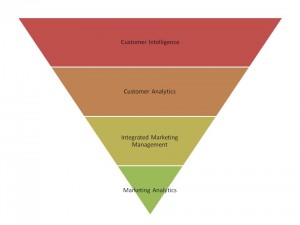 In the first post in this series, we discussed how there are a number of terms that describe how organizations manage their customer engagements: customer intelligence, customer analytics, integrated marketing management and marketing analytics. My goal with this series of posts was to clarify the definitions among the terms, delineate what comprises each term and highligh which solution sets apply.
In the first post in this series, we discussed how there are a number of terms that describe how organizations manage their customer engagements: customer intelligence, customer analytics, integrated marketing management and marketing analytics. My goal with this series of posts was to clarify the definitions among the terms, delineate what comprises each term and highligh which solution sets apply.
Today, let's focus on our fourth and final term: Marketing Analytics.
Marketing analytics comprises the processes and technologies that enable marketers to evaluate the success of their marketing initiatives by measuring their performance using important business metrics, such as ROI, marketing attribution and overall marketing effectiveness – not just marketing channel effectiveness.
I think of marketing analytics as being like a fine wine – good marketing analytics programs are strong and sound, full bodied, and have a flavor for the data that is coveted by other departments in the organization. Many companies today simply can not join all marketing channel data in a common view and then analyze that data for needed insight. There are many reasons for this – culture, technical barriers, lack of information, etc. – but that discussion is for another post!
Without the ability to achieve that common view, marketers make decisions based on data from individual channels (website metrics, for example), and therefore not taking into account the entire marketing picture. Social media data alone is not enough. Web analytics data alone is not enough. And tools that look at just a snapshot in time for a single channel are woefully inadequate. By contrast, marketing analytics gathers data from across all marketing channels and consolidates it into a common marketing view. From this common view, you can extract analytical results that can provide invaluable assistance in driving your marketing efforts forward. Marketing analytics enables you to answer such questions as:
- How did email campaign A perform against direct mail campaign B?
- How many leads did I generate from blog post C versus social media campaign D?
- Which had the biggest impact from a marketing attribution point of view – A, B, C or D?
Applied holistically, marketing analytics allows for better lead nurturing and management, which leads to more revenue and greater profitability. By more effectively managing leads and being able to tie those leads to sales – which is known as closed-loop marketing analytics – you can see which specific marketing initiatives are contributing to your bottom line.
Knowing the need for marketers to manage such a broad spectrum, SAS has created a complete suite of marketing analytics capabilities, including solutions such as:
- Marketing Mix Analysis – Predict the business value of investments, such as advertising, incentives and the Web.
- Marketing Performance Management – Align activities and resources to strategies and goals, link marketing performance to financial measures and establish accountability throughout the marketing department.
- Marketing Operations – Plan, manage and execute enterprise marketing operations efficiently and effectively.
- Intelligent Advertising – Gather and present data to enable precision forecasting, decision optimization, inventory management and sales performance reporting.
- Adaptive Customer Experience – Develop more relevant, personalized communications to achieve better marketing performance.
With an integrated marketing analytics stack, organizations are able to derive value from marketing initiatives. Here are a couple examples that use marketing analytics from SAS:
- Photobucket increases profitability by better understanding marketing and sales channels.
- Fratelli Carli manages marketing and sales operations data with integrated marketing analytics.
- Quarter Media manages online advertising while derives insight from marketing analytics.
So now we have covered them these terms! Hopefully this series of blog posts has helped you further differentiate between these commonly used terms. I know it has helped me as I continue to explore how SAS can best help organizations tackle their customer intelligence, customer analytics, integrated marketing management, and marketing analytics initiatives.
Please comment and share your thoughts and as always, thanks for reading along!
